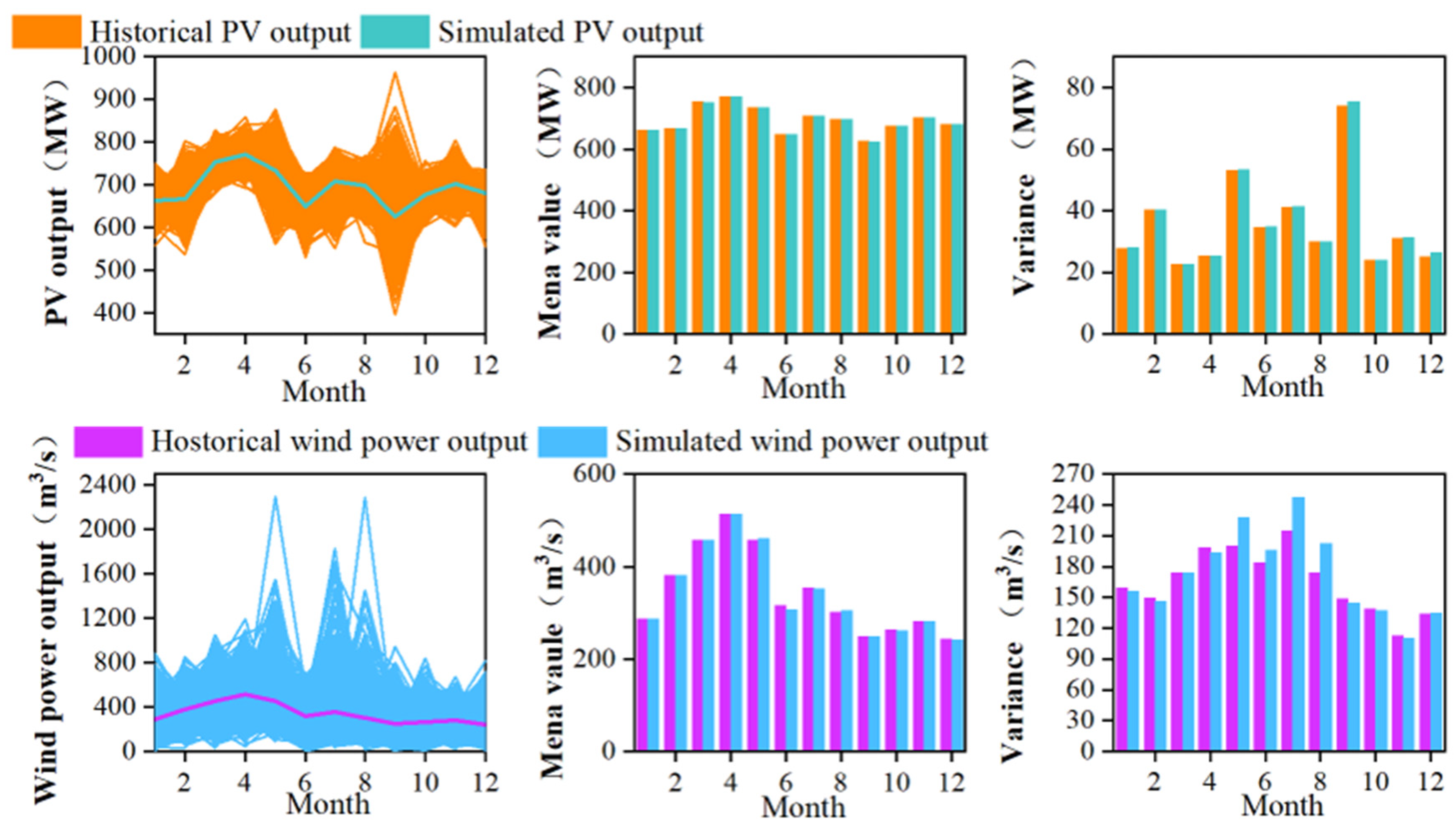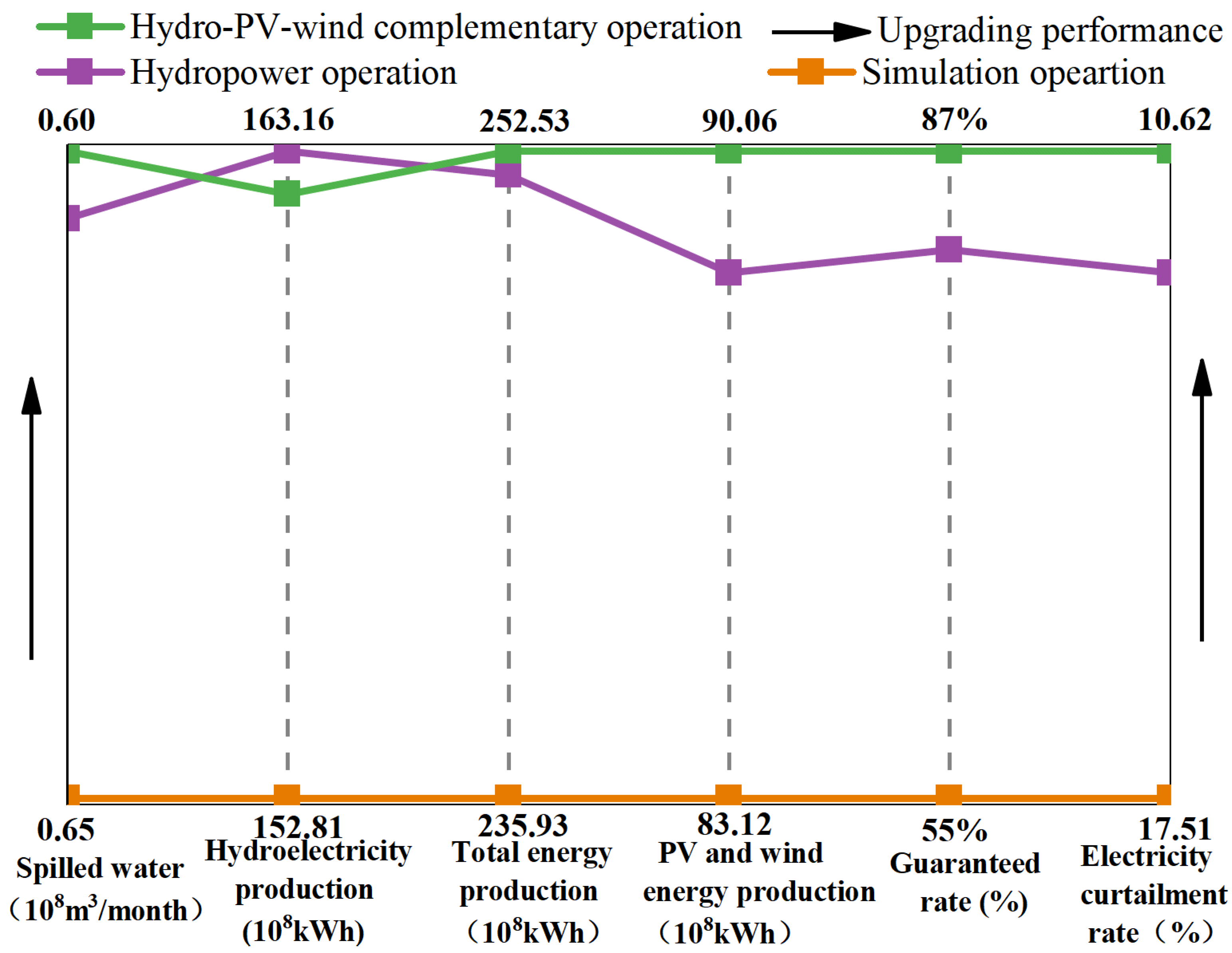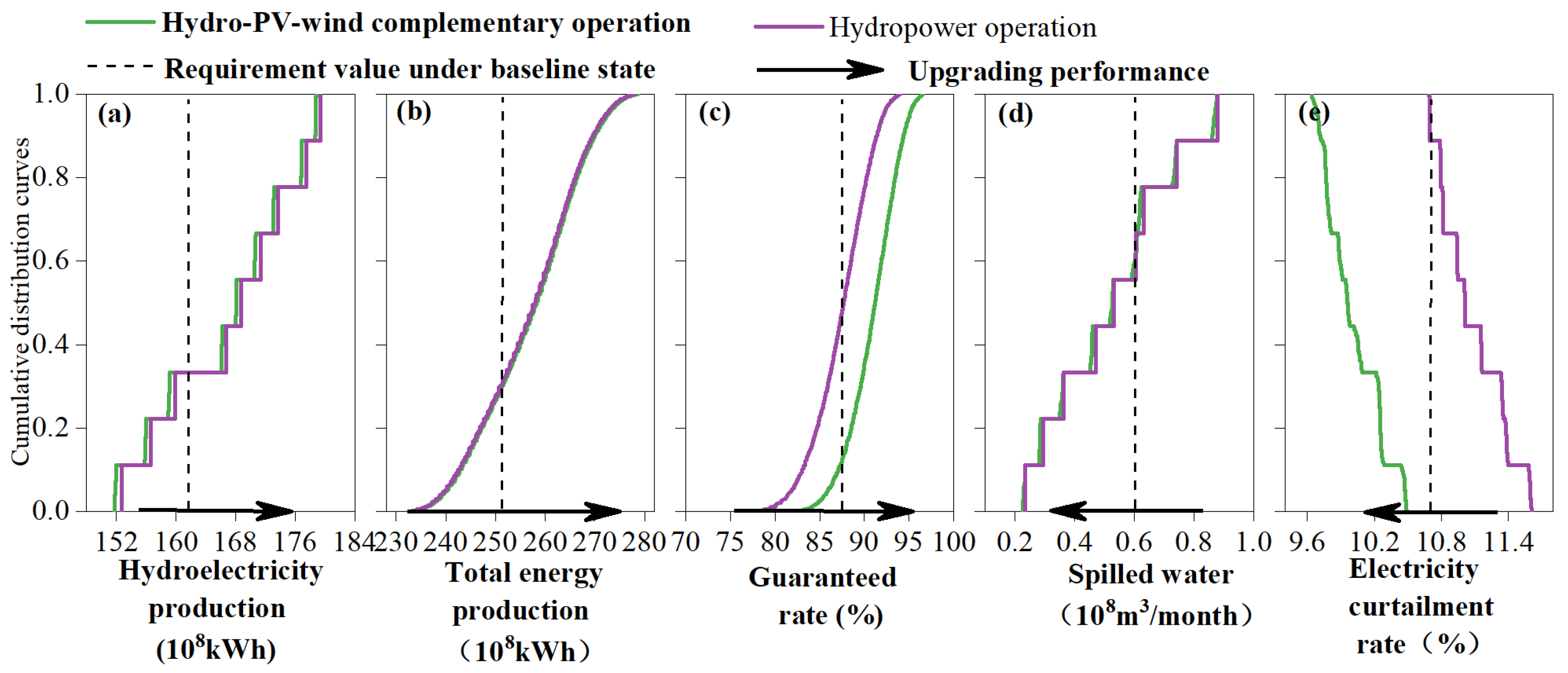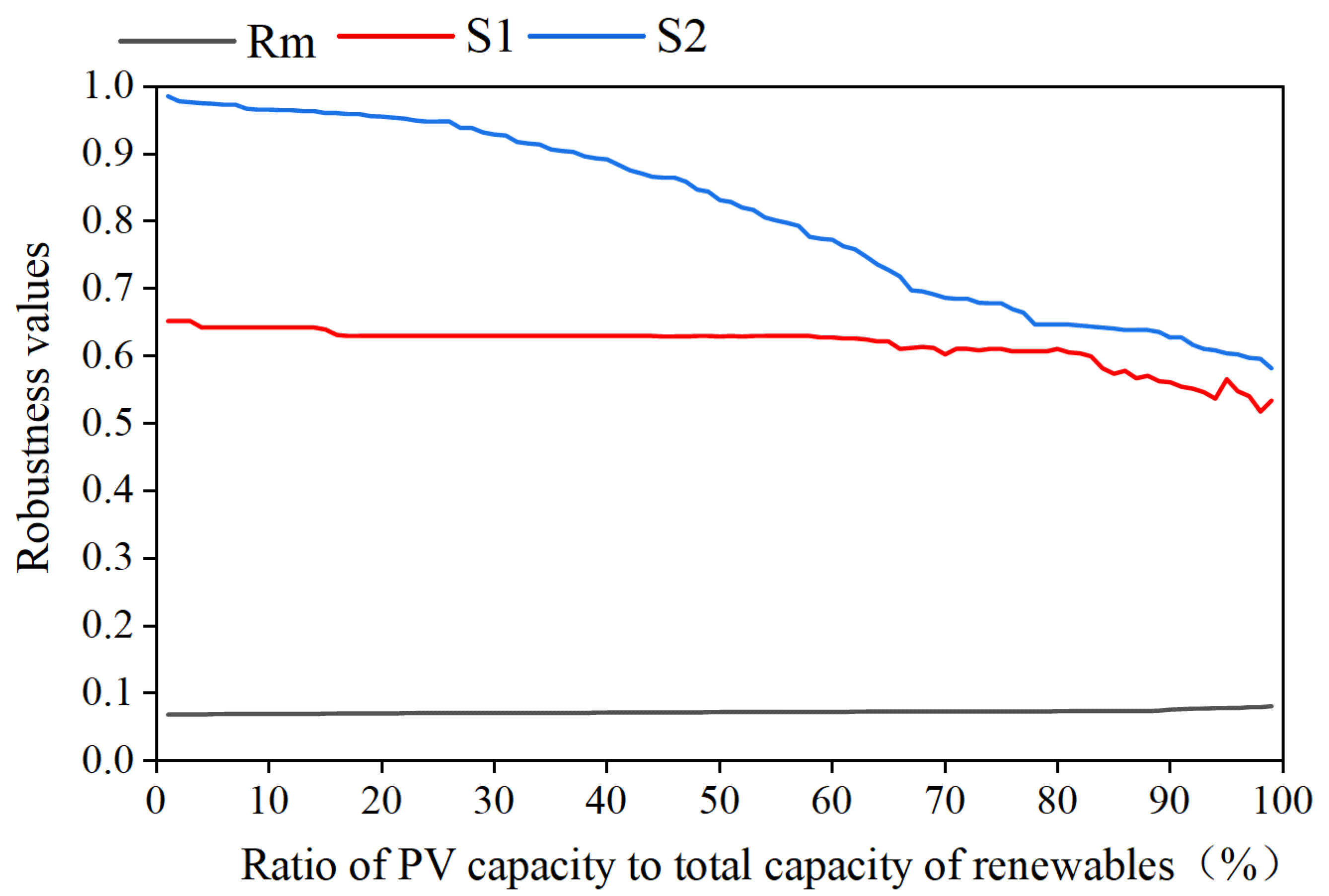Operational Robustness Assessment of the Hydro-Based Hybrid Generation System under Deep Uncertainties
Abstract
:1. Introduction
2. Methods
2.1. Multivariate Stochastic Simulation
2.2. Long-Term Optimization Model Considering Intraday Electricity Curtailment of the HGS
2.2.1. Objectives of the Long-Term Operation Model
2.2.2. Solving Method
2.3. Robustness Indicators
- (1)
- Improved regret-based indicator Rm
- (2)
- Satisfied-based indicator S1
- (3)
- Satisfied-based indicator S2
2.4. Sensitivity Analysis of HGS Robustness
3. Case Study
4. Results and Discussion
4.1. Simulation Results of the Inflow, PV, and Wind Power Series
4.2. Long-Term Operation Results
4.3. Robustness Assessment of the HGS
4.4. Sensitivity Analysis of the HGS’s Robustness
4.4.1. Inflow PV and Wind Power Series Factors
4.4.2. Total Capacity and Capacity Ratio Factors
5. Conclusions and Prospects
- (1)
- Long-term hydro-PV-wind complementary operation can significantly enhance the technical and economic performance in the historical state and the system’s robustness under uncertain resource scenarios, albeit by sacrificing hydropower generation performance.
- (2)
- When the robustness of the HGS is considered in terms of the comprehensive complementary performance, there is higher sensitivity to changes in inflow, followed by variations in PV and wind power. However, when the power supply reliability is the primary focus, the HGS is most sensitive to changes in PV power.
- (3)
- The HGS’s robustness weakens as the total capacity of PV and wind power plants increases. Moreover, the robustness is initially unchanged before becoming weaker as the PV capacity ratio increases. Notably, the robustness of the HGS demonstrates higher sensitivity to changes in the total capacity than to changes in the capacity ratio.
Author Contributions
Funding
Data Availability Statement
Conflicts of Interest
References
- Brockway, P.E.; Owen, A.; Brand-Correa, L.I.; Hardt, L. Estimation of Global Final-Stage Energy-Return-on-Investment for Fossil Fuels with Comparison to Renewable Energy Sources. Nat. Energy 2019, 4, 612–621. [Google Scholar] [CrossRef]
- Yang, S.; Fang, D.; Chen, B. Human Health Impact and Economic Effect for PM2.5 Exposure in Typical Cities. Appl. Energy 2019, 249, 316–325. [Google Scholar] [CrossRef]
- Canales, F.A.; Jurasz, J.; Beluco, A.; Kies, A. Assessing Temporal Complementarity between Three Variable Energy Sources through Correlation and Compromise Programming. Energy 2020, 192, 116637. [Google Scholar] [CrossRef]
- Ma, X.Y.; Sun, Y.Z.; Fang, H.L. Scenario Generation of Wind Power Based on Statistical Uncertainty and Variability. IEEE Trans. Sustain. Energy 2013, 4, 894–904. [Google Scholar] [CrossRef]
- Ma, C.; Xu, X.; Pang, X.; Li, X.; Zhang, P.; Liu, L. Scenario-Based Ultra-Short-Term Rolling Optimal Operation of a Photovoltaic-Energy Storage System under Forecast Uncertainty. Appl. Energy 2024, 356, 122425. [Google Scholar] [CrossRef]
- Ávila, L.; Mine, M.R.M.; Kaviski, E.; Detzel, D.H.M. Evaluation of Hydro-Wind Complementarity in the Medium-Term Planning of Electrical Power Systems by Joint Simulation of Periodic Streamflow and Wind Speed Time Series: A Brazilian Case Study. Renew. Energy 2021, 167, 685–699. [Google Scholar] [CrossRef]
- Xu, B.; Zhu, F.; Zhong, P.-a.; Chen, J.; Liu, W.; Ma, Y.; Guo, L.; Deng, X. Identifying Long-Term Effects of Using Hydropower to Complement Wind Power Uncertainty through Stochastic Programming. Appl. Energy 2019, 253, 113535. [Google Scholar] [CrossRef]
- Ding, Z.; Wen, X.; Tan, Q.; Yang, T.; Fang, G.; Lei, X.; Zhang, Y.; Wang, H. A Forecast-Driven Decision-Making Model for Long-Term Operation of a Hydro-Wind-Photovoltaic Hybrid System. Appl. Energy 2021, 291, 116820. [Google Scholar] [CrossRef]
- Yuan, W.; Wang, X.; Su, C.; Cheng, C.; Liu, Z.; Wu, Z. Stochastic Optimization Model for the Short-Term Joint Operation of Photovoltaic Power and Hydropower Plants Based on Chance-Constrained Programming. Energy 2021, 222, 119996. [Google Scholar] [CrossRef]
- Zhu, F.; Zhong, P.-A.; Xu, B.; Liu, W.; Wang, W.; Sun, Y.; Chen, J.; Li, J. Short-Term Stochastic Optimization of a Hydro-Wind-Photovoltaic Hybrid System under Multiple Uncertainties. Energy Convers. Manag. 2020, 214, 112902. [Google Scholar] [CrossRef]
- Steffen, W.; Richardson, K.; Rockström, J.; Cornell, S.E.; Fetzer, I.; Bennett, E.M.; Biggs, R.; Carpenter, S.R.; De Vries, W.; De Wit, C.A.; et al. Planetary Boundaries: Guiding Human Development on a Changing Planet. Science 2015, 347, 736–746. [Google Scholar] [CrossRef] [PubMed]
- Scholze, M.; Knorr, W.; Arnell, N.W.; Prentice, I.C. A Climate-Change Risk Analysis for World Ecosystems. Proc. Natl. Acad. Sci. USA 2006, 103, 13116–13120. [Google Scholar] [CrossRef] [PubMed]
- Walther, G.R.; Post, E.; Convey, P.; Menzel, A.; Parmesan, C.; Beebee, T.J.C.; Fromentin, J.M.; Hoegh-Guldberg, O.; Bairlein, F. Ecological Responses to Recent Climate Change. Nature 2002, 416, 389–395. [Google Scholar] [CrossRef] [PubMed]
- François, B.; Hingray, B.; Borga, M.; Zoccatelli, D.; Brown, C.; Creutin, J.D. Impact of Climate Change on Combined Solar and Run-of-River Power in Northern Italy. Energies 2018, 11, 290. [Google Scholar] [CrossRef]
- Perera, A.T.D.; Javanroodi, K.; Nik, V.M. Climate Resilient Interconnected Infrastructure: Co-Optimization of Energy Systems and Urban Morphology. Appl. Energy 2021, 285, 116430. [Google Scholar] [CrossRef]
- Nik, V.M.; Perera, A.T.D.; Chen, D. Towards Climate Resilient Urban Energy Systems: A Review. Natl. Sci. Rev. 2021, 8, nwaa134. [Google Scholar] [CrossRef] [PubMed]
- Jin, X.; Liu, B.; Liao, S.; Cheng, C.; Zhang, Y.; Zhao, Z.; Lu, J. Wasserstein Metric-Based Two-Stage Distributionally Robust Optimization Model for Optimal Daily Peak Shaving Dispatch of Cascade Hydroplants under Renewa-ble Energy Uncertainties. Energy 2022, 260, 125107. [Google Scholar] [CrossRef]
- Zhou, Y.; Zhao, J.; Zhai, Q. 100% Renewable Energy: A Multi-Stage Robust Scheduling Approach for Cascade Hydropower System with Wind and Photovoltaic Power. Appl. Energy 2021, 301, 117441. [Google Scholar] [CrossRef]
- Jiang, J.; Ming, B.; Huang, Q.; Chang, J.; Liu, P.; Zhang, W.; Ren, K. Hybrid Generation of Renewables Increases the Energy System’s Robustness in a Changing Climate. J. Clean. Prod. 2021, 324, 129205. [Google Scholar] [CrossRef]
- Shortridge, J.E.; Zaitchik, B.F. Characterizing Climate Change Risks by Linking Robust Decision Frameworks and Uncertain Probabilistic Projections. Clim. Chang. 2018, 151, 525–539. [Google Scholar] [CrossRef]
- Ghimire, S.; Deo, R.C.; Casillas-Pérez, D.; Salcedo-Sanz, S. Boosting Solar Radiation Predictions with Global Climate Models, Observational Predictors and Hybrid Deep-Machine Learning Algorithms. Appl. Energy 2022, 316, 119063. [Google Scholar] [CrossRef]
- Mei, H.; Li, Y.P.; Suo, C.; Ma, Y.; Lv, J. Analyzing the Impact of Climate Change on Energy-Economy-Carbon Nexus System in China. Appl. Energy 2020, 262, 114568. [Google Scholar] [CrossRef]
- Kirchner, M.; Mitter, H.; Schneider, U.A.; Sommer, M.; Falkner, K.; Schmid, E. Uncertainty Concepts for Integrated Modeling—Review and Application for Identifying Uncertainties and Uncertainty Propagation Pathways. Environ. Model. Softw. 2021, 135, 104905. [Google Scholar] [CrossRef]
- Borgomeo, E.; Farmer, C.L.; Hall, J.W. Numerical Rivers: A Synthetic Streamflow Generator for Water Resources Vulnerability Assessments. Water Resour. Res. 2015, 51, 5382–5405. [Google Scholar] [CrossRef]
- Su, C.; Cheng, C.; Wang, P.; Shen, J.; Wu, X. Optimization Model for Long-Distance Integrated Transmission of Wind Farms and Pumped-Storage Hydropower Plants. Appl. Energy 2019, 242, 285–293. [Google Scholar] [CrossRef]
- Lu, L.; Yuan, W.; Su, C.; Wang, P.; Cheng, C.; Yan, D.; Wu, Z. Optimization Model for the Short-Term Joint Operation of a Grid-Connected Wind-Photovoltaic-Hydro Hybrid Energy System with Cascade Hydropower Plants. Energy Convers. Manag. 2021, 236, 114055. [Google Scholar] [CrossRef]
- Favre, A.C.; El Adlouni, S.; Perreault, L.; Thiémonge, N.; Bobée, B. Multivariate Hydrological Frequency Analysis Using Copulas. Water Resour. Res. 2004, 40, 1–12. [Google Scholar] [CrossRef]
- Genest, C.; Favre, A.C.; Béliveau, J.; Jacques, C. Metaelliptical Copulas and Their Use in Frequency Analysis of Multivariate Hydrological Data. Water Resour. Res. 2007, 43. [Google Scholar] [CrossRef]
- Li, Y.; Huang, S.; Wang, H.; Huang, Q.; Li, P.; Zheng, X.; Wang, Z.; Jiang, S.; Leng, G.; Li, J.; et al. Warming and Greening Exacerbate the Propagation Risk from Meteorological to Soil Moisture Drought. J. Hydrol. 2023, 622, 129716. [Google Scholar] [CrossRef]
- Jiang, J.; Ming, B.; Liu, P.; Huang, Q.; Guo, Y.; Chang, J.; Zhang, W. Refining Long-Term Operation of Large Hydro–Photovoltaic–Wind Hybrid Systems by Nesting Response Functions. Renew. Energy 2023, 204, 359–371. [Google Scholar] [CrossRef]
- Wang, H.; Lei, X.; Guo, X.; Jiang, Y.; Zhao, T.; Wang, X.; Liao, W. Multi-Reservoir System Operation Theory and Practice. In Advances in Water Resources Management; Springer: Berlin/Heidelberg, Germany, 2016. [Google Scholar]
- Hall, J.W.; Lempert, R.J.; Keller, K.; Hackbarth, A.; Mijere, C.; Mcinerney, D.J. Robust Climate Policies Under Uncertainty: A Comparison of Robust Decision Making and Info-Gap Methods. Risk Anal. 2012, 32, 1657–1672. [Google Scholar] [CrossRef] [PubMed]
- Razavi, S.; Jakeman, A.; Saltelli, A.; Prieur, C.; Iooss, B.; Borgonovo, E.; Plischke, E.; Lo Piano, S.; Iwanaga, T.; Becker, W.; et al. The Future of Sensitivity Analysis: An Essential Discipline for Systems Modeling and Policy Support. Environ. Model. Softw. 2021, 137, 104954. [Google Scholar] [CrossRef]
- Wang, Z.; Wen, X.; Tan, Q.; Fang, G.; Lei, X.; Wang, H.; Yan, J. Potential Assessment of Large-Scale Hydro-Photovoltaic-Wind Hybrid Systems on a Global Scale. Renew. Sustain. Energy Rev. 2021, 146, 111154. [Google Scholar] [CrossRef]
- Li, Y.; Ming, B.; Huang, Q.; Wang, Y.; Liu, P.; Guo, P. Identifying Effective Operating Rules for Large Hydro–Solar–Wind Hybrid Systems Based on an Implicit Stochastic Optimization Framework. Energy 2022, 245, 123260. [Google Scholar] [CrossRef]
- Jiang, J.; Ming, B.; Huang, Q.; Guo, Y.; Shang, J.; Jurasz, J.; Liu, P. A Holistic Techno-Economic Evaluation Framework for Sizing Renewable Power Plant in a Hydro-Based Hybrid Generation System. Appl. Energy 2023, 348, 121537. [Google Scholar] [CrossRef]










| Parameters | Cihaxia | Banduo | Yangqu | Units |
|---|---|---|---|---|
| Installed capacity | 2600 | 360 | 1200 | MW |
| Dead water level | 2950 | 2757 | 2710 | m |
| Normal water level | 2990 | 2760 | 2715 | m |
| Active storage | 1854 | 2 | 239 | million m3 |
| Upper limit of outflow | 6000 | 6000 | 6000 | m3/s |
| Average hydraulic head | 219.1 | 35.8 | 117.8 | m |
| Lower limit of outflow | 200 | 200 | 200 | m3/s |
| Regulation ability | Seasonal | Daily | Daily | / |
| Uncertainty Scenario | Cihaxia Inflow (m3/s) | Banduo Inflow (m3/s) | Yangqu Inflow (m3/s) | PV Power Output (MW) | Wind Power Output (MW) | |||||
|---|---|---|---|---|---|---|---|---|---|---|
| Historical | Simulated | Historical | Simulated | Historical | Simulated | Historical | Simulated | Historical | Simulated | |
| −10% | 521.6 | 521.3 | 522.2 | 521.3 | 647.2 | 646.3 | 693.8 | 693.1 | 342.0 | 340.9 |
| −9% | 527.4 | 525.2 | 528.0 | 525.2 | 654.4 | 652.6 | 701.5 | 700.8 | 345.8 | 344.7 |
| −8% | 533.2 | 539.1 | 533.8 | 539.1 | 661.6 | 669.2 | 709.2 | 708.5 | 349.6 | 348.4 |
| −7% | 539.0 | 533.5 | 539.6 | 533.5 | 668.8 | 666.2 | 716.9 | 716.2 | 353.4 | 352.2 |
| −6% | 544.8 | 546.1 | 545.4 | 546.1 | 676.0 | 675.4 | 724.6 | 723.9 | 357.2 | 356.0 |
| −5% | 550.6 | 559.9 | 551.2 | 559.9 | 683.2 | 692.6 | 732.3 | 731.6 | 361.0 | 359.8 |
| −4% | 556.4 | 564.9 | 557.0 | 564.9 | 690.3 | 701.7 | 740.0 | 739.3 | 364.8 | 363.6 |
| −3% | 562.2 | 560.3 | 562.8 | 560.3 | 697.5 | 695.4 | 747.7 | 747.0 | 368.6 | 367.4 |
| −2% | 568.0 | 577.2 | 568.6 | 577.2 | 704.7 | 715.3 | 755.4 | 754.7 | 372.4 | 371.2 |
| −1% | 573.8 | 579.3 | 574.4 | 579.3 | 711.9 | 716.3 | 763.1 | 762.4 | 376.2 | 374.9 |
| 0% | 579.6 | 582.7 | 580.2 | 582.7 | 719.1 | 722.4 | 770.8 | 770.1 | 380.0 | 378.7 |
| 1% | 585.4 | 595.6 | 586.0 | 595.6 | 726.3 | 737.9 | 778.5 | 777.8 | 383.8 | 382.5 |
| 2% | 591.1 | 589.3 | 591.8 | 589.3 | 733.5 | 734.2 | 786.3 | 785.5 | 387.6 | 386.3 |
| 3% | 596.9 | 596.5 | 597.6 | 596.5 | 740.7 | 739.2 | 794.0 | 793.2 | 391.4 | 390.1 |
| 4% | 602.7 | 616.3 | 603.4 | 616.3 | 747.9 | 760.7 | 801.7 | 800.9 | 395.2 | 393.9 |
| 5% | 608.5 | 608.3 | 609.2 | 608.3 | 755.1 | 756.1 | 809.4 | 808.6 | 399.0 | 397.7 |
| 6% | 614.3 | 621.9 | 615.0 | 621.9 | 762.3 | 769.0 | 817.1 | 816.3 | 402.8 | 401.5 |
| 7% | 620.1 | 630.9 | 620.8 | 630.9 | 769.4 | 781.9 | 824.8 | 824.0 | 406.6 | 405.2 |
| 8% | 625.9 | 641.7 | 626.6 | 641.7 | 776.6 | 789.9 | 832.5 | 831.7 | 410.4 | 409.0 |
| 9% | 631.7 | 635.5 | 632.4 | 635.5 | 783.8 | 787.6 | 840.2 | 839.4 | 414.2 | 412.8 |
| 10% | 637.5 | 642.8 | 638.2 | 642.8 | 791.0 | 798.7 | 847.9 | 847.1 | 418.0 | 416.6 |
| Maximum deviation | 2.5% | 2.4% | 1.7% | 0.1% | 0.3% | |||||
| Mean deviation | 1.0% | 1.0% | 0.8% | 0.1% | 0.3% | |||||
| Uncertainty Scenario | Cihaxia Inflow (m3/s) | Banduo Inflow (m3/s) | Yangqu Inflow (m3/s) | PV Power Output (MW) | Wind Power Output (MW) | |||||
|---|---|---|---|---|---|---|---|---|---|---|
| Historical | Simulated | Historical | Simulated | Historical | Simulated | Historical | Simulated | Historical | Simulated | |
| −10% | 408.4 | 405.3 | 408.9 | 405.3 | 506.8 | 474.4 | 56.3 | 56.8 | 188.5 | 197.4 |
| −9% | 413.0 | 411.4 | 413.4 | 411.4 | 512.4 | 481.8 | 56.9 | 57.4 | 190.6 | 199.6 |
| −8% | 417.5 | 423.5 | 418.0 | 423.5 | 518.0 | 494.5 | 57.5 | 58.1 | 192.6 | 201.8 |
| −7% | 422.0 | 413.7 | 422.5 | 413.7 | 523.7 | 486.5 | 58.1 | 58.7 | 194.7 | 204.0 |
| −6% | 426.6 | 426.2 | 427.0 | 426.2 | 529.3 | 497.5 | 58.8 | 59.3 | 196.8 | 206.2 |
| −5% | 431.1 | 435.6 | 431.6 | 435.6 | 534.9 | 508.9 | 59.4 | 60.0 | 198.9 | 208.4 |
| −4% | 435.7 | 441.4 | 436.1 | 441.4 | 540.6 | 518.6 | 60.0 | 60.6 | 201.0 | 210.6 |
| −3% | 440.2 | 437.2 | 440.7 | 437.2 | 546.2 | 511.3 | 60.6 | 61.2 | 203.1 | 212.8 |
| −2% | 444.7 | 451.0 | 445.2 | 451.0 | 551.8 | 527.2 | 61.3 | 61.9 | 205.2 | 214.9 |
| −1% | 449.3 | 453.2 | 449.8 | 453.2 | 557.5 | 527.8 | 61.9 | 62.5 | 207.3 | 217.1 |
| 0% | 453.8 | 457.3 | 454.3 | 457.3 | 563.1 | 533.9 | 62.5 | 63.1 | 209.4 | 219.3 |
| 1% | 458.3 | 463.8 | 458.9 | 463.8 | 568.7 | 541.9 | 63.1 | 63.7 | 211.5 | 221.5 |
| 2% | 462.9 | 460.2 | 463.4 | 460.2 | 574.3 | 540.1 | 63.8 | 64.4 | 213.6 | 223.7 |
| 3% | 467.4 | 465.5 | 467.9 | 465.5 | 580.0 | 542.7 | 64.4 | 65.0 | 215.7 | 225.9 |
| 4% | 472.0 | 480.5 | 472.5 | 480.5 | 585.6 | 560.5 | 65.0 | 65.6 | 217.8 | 228.1 |
| 5% | 476.5 | 479.1 | 477.0 | 479.1 | 591.2 | 559.1 | 65.6 | 66.3 | 219.9 | 230.3 |
| 6% | 481.0 | 485.8 | 481.6 | 485.8 | 596.9 | 566.8 | 66.3 | 66.9 | 222.0 | 232.5 |
| 7% | 485.6 | 492.6 | 486.1 | 492.6 | 602.5 | 576.7 | 66.9 | 67.5 | 224.1 | 234.7 |
| 8% | 490.1 | 507.1 | 490.7 | 507.1 | 608.1 | 586.5 | 67.5 | 68.2 | 226.2 | 236.9 |
| 9% | 494.7 | 500.8 | 495.2 | 500.8 | 613.8 | 584.1 | 68.1 | 68.8 | 228.2 | 239.1 |
| 10% | 499.2 | 501.4 | 499.7 | 501.4 | 619.4 | 587.1 | 68.8 | 69.4 | 230.3 | 241.3 |
| Maximum deviation | 3.5% | 3.3% | 7.1% | 1.0% | 4.7% | |||||
| Mean deviation | 1.1% | 1.1% | 5.2% | 1.0% | 4.7% | |||||
| Sensitive Factors | Rm | S1 | S2 |
|---|---|---|---|
| Installed capacity factor | 0.0672 | 0.1727 | 0.1512 |
| Capacity ratio factor | 0.0025 | 0.0295 | 0.1341 |
Disclaimer/Publisher’s Note: The statements, opinions and data contained in all publications are solely those of the individual author(s) and contributor(s) and not of MDPI and/or the editor(s). MDPI and/or the editor(s) disclaim responsibility for any injury to people or property resulting from any ideas, methods, instructions or products referred to in the content. |
© 2024 by the authors. Licensee MDPI, Basel, Switzerland. This article is an open access article distributed under the terms and conditions of the Creative Commons Attribution (CC BY) license (https://creativecommons.org/licenses/by/4.0/).
Share and Cite
Jiang, J.; Ming, B.; Huang, Q.; Bai, Q. Operational Robustness Assessment of the Hydro-Based Hybrid Generation System under Deep Uncertainties. Energies 2024, 17, 1974. https://doi.org/10.3390/en17081974
Jiang J, Ming B, Huang Q, Bai Q. Operational Robustness Assessment of the Hydro-Based Hybrid Generation System under Deep Uncertainties. Energies. 2024; 17(8):1974. https://doi.org/10.3390/en17081974
Chicago/Turabian StyleJiang, Jianhua, Bo Ming, Qiang Huang, and Qingjun Bai. 2024. "Operational Robustness Assessment of the Hydro-Based Hybrid Generation System under Deep Uncertainties" Energies 17, no. 8: 1974. https://doi.org/10.3390/en17081974






